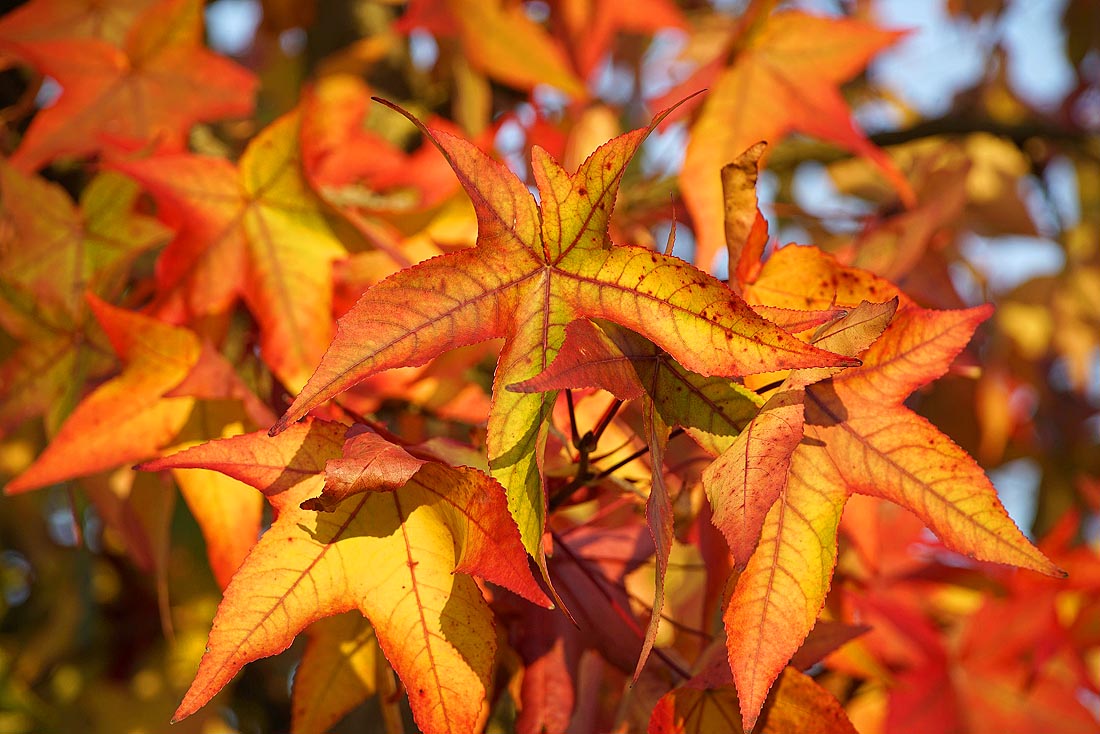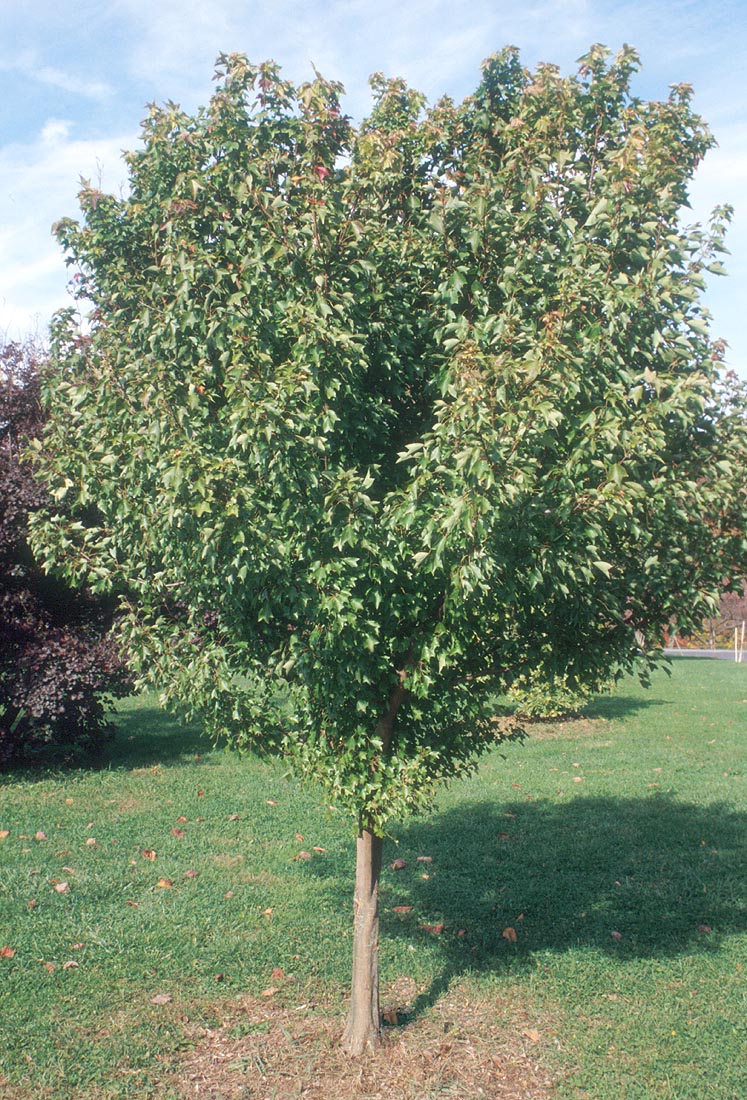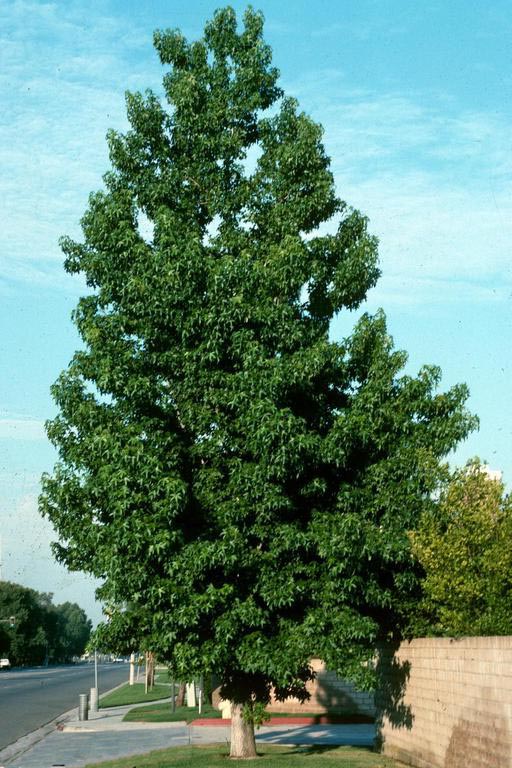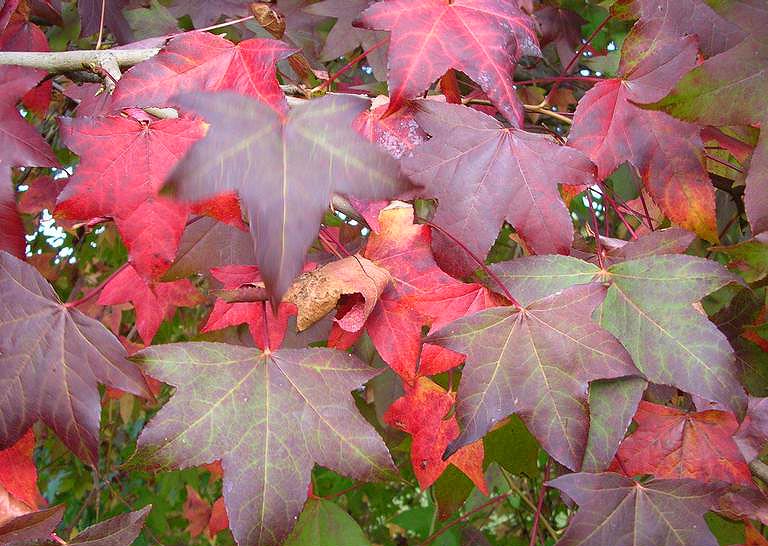Native American shade tree that is easy to grow and provides attractive fall color. Grows very rapidly to begin with creating small trees quickly once it reaches 12-15 feet (3.6-4.5m) the growth rate slows down. Given enough space it forms a pleasant pyramid shade with unique star-shaped leaves that turn shades of yellow red and purple all on the same leaf providing lovely autumn color. Its a long lived tree with deep roots making it less likely to fall during high winds and storms. Grows well in most soils that are well drained and produces some very attractive wood. The resin collected from the trunk or green gumballs is used medicinally. The downside is the gumballs that fall throughout the winter months. Many homeowners don't like them as they can be annoying to clear up and unpleasant to step on. They are very tough and don't easily rot making them excellent for art projects both indoors and outside. Your imagination is the only limit.
The leaves are uniquely star shaped (technically palmate) and up to 7 inches (18 cm) across with 5 sharp pointed lobes. However some leave can have 3, 4 or 7 lobes. Leaves are flat, dark green with long stalks and very fragrant when bruised. In autumn they turn color in shades of red, orange, yellow, purple and burgundy. Often on the same leaf with the center (palm) of the leaf being red and yellow with the points purple and deep burgundy. It is truly beautiful to behold, however colors are not as vibrant in warmer southern zones.
The flowers come in two forms male and female. The male flowers are large clusters that can be up to 3 inches (7.6cm) long and 1.5 inches (3.7 cm) wide and look like long think broccoli heads. Since they are green in color with tints of yellow or red but are not often seen on the trees but are noticeable when the fall to the ground after pollination which is by wind to the female flowers that remain on the tree and look like small stalked curly green balls. Once pollinated these begin to grow and swell into larger green spiky balls up to 1.5 inches (3.7 cm) in diameter and are known as 'gumballs' that later turn brown and begin to fall. Not all the seed pods fall at the same time and often many remain on the tree until the following spring, often even later. The gives the tree the appearance of being decorated with Christmas tree ornaments which is why it is sometimes call the Christmas ornament tree. It is often a good way of identifying this tree in the winter months. Another feature is that small branches often develop corky ridges like narrow fins on two or more sides making them easy to identify. The bark is deeply ridged and reminiscent of alligator skin giving it another came of Alligator Tree & Alligatorwood.
Growing American Sweetgum (Liquidambar Styraciflua) from Seed.
Seeds need a period of cold before they germinate. All our seeds are kept cold to help with this process. Most Sweetgum seeds don't need much moist stratification but some extra work is needed.
Keep seeds in the refrigerator until ready to plant. Then soak the seeds in water for a couple of hours. Remove seeds from water and place on a moist paper towel. Put this in a plastic bag and return seeds to the refrigerator for two days at least. The remove and plant as regular seeds.
Sow seeds in small pots or cell pots where seeds have their own space. Place in cool but sunny location and keep moist start with temperatures around 60 F (15.5 C) and slowly increase the temperature over a period of about 2 weeks to 72 F (22.2C). Germination can be erratic depending on many factors so be patient. If planting several seeds to a pot carefully transplant seedlings to individual pots once they have developed more than two true leaves or just thin the pots to one individual. Once seedlings reach 4 inches (10cm) they can be moved outside after danger of frost is past, keep in semi shaded location gradually moving into sunshine to harden off. For more details see our Growing Trees from Seeds article.
Grow on transplanting to larger and larger pots until the seedlings are 18 inches (45.7cm) tall then transplant to the final location.
IMPORTANT. Sweetgum trees produce very long tap roots. They will create long roots first before increasing top growth height. Therefore it is vital that the seedlings are planting in long pots, known as tree pots. If you don't have any tree pots and are intending to grow only a few trees for your garden these pots can be easily made by duck taping several other pots together. Tree roots can be several feet long (2 meters or more) for a top growth of only 18 inches (45.7cm). If trees are left in regular pots it can stunt their roots and kill tree seedlings. See our tree growing guide for more information.
Likes full sun location and space. Will develop its beautiful shape only if give the room.
Dig a deep hole to accommodate the length of the root, do not curl the root up in a shallow hole this can stunt the trees growth. If planted in pots that are too shallow and the roots have curled around the pot it is important to tease out the roots before planting. Any root curling around can grow into a girdling root which can strangle the tree and kill it.
Add some good compost to the soil that you are replacing in the hole and holding the tree in the center of the hole fill it back in, gently treading on the soil to firm it around the seedling. Place chicken wire around the tree to protect it from wildlife as it establishes itself. Water weekly, more if there is drought for the first year, less if the tree begins to increase in height. After this the tree should be fine on its own unless there is drought.
Mulch around the base of the tree out to the drip line where the feeding roots are located. This will keep weeds from forming around the base and help keep moisture around the tree. Keep mulch ate least 4 inches (10cm) then 6-8 inches (15.2-20.3cm) from the tree trunk as the tree grows to prevent rodent damage.
The leaves, bark and seeds also contain beneficial compounds one, shikimic acid is a precursor to the active ingredient in Tamiflu®-an antiviral drug effective against several influenza viruses. Other compounds have been found effective in treatments of hypertension and epilepsy and as a general anticonvulsive.
While the sap is harder to collect the same compounds exist in the green gumballs so its best to collect these and tincture them for use in treating most of these issues especially as a alternative to things like Tamiflu. Its use for this purpose is still under debate, some find it very effective others don't have such glowing reports. However there is no documentation on how the resin/extract was prepared and this can be a major factor in how effective any medication is.
Some reports state that only the green gumballs contain the required substances, others suggest the leaves can also be used. Still others state that the unripe seeds (inside the gumballs) are required while others still focus on the 'chaff' that accompanies the Sweetgum seeds stating that this contains shikimic acid too. However very little seems to be known about what this chaff even is, some say its unfertilized seed others say its 'stuff to help the seeds disperse' but basically no one seems to know. So whether its useful or not is still supposition.
Scented bathing. Leaves are added to boiling water then cooled before being added to bathwater for a scented bath that can also remove pests.
Wood. Produces a strong hard wood that has a truly lovely appearance, light with dark lines making it very attractive for furniture, flooring and other wooden objects.
Bark. Can be used in basket making.
Fungi food. Useful for growing wood loving fungi such as shitake, oyster and others.
About 'Gumballs'.
While many home owners find these annoying and its certainly true that stepping on them can be a hazard. One of the reasons for that is because they are so durable. The tough spiky balls don't rot down quickly. This can be annoying if you want to remove them but extremely useful for many other projects. Since they don't rot they can be formed into sculptures, piled into wire bins to make, fences, different sculptures or whatever you want. These can also double as insect habitat to help increase important insect populations. Indoors they are also used in a wide variety of decorative projects such as Christmas decorations, potpourri, wreaths, animal figurines. They can also be tossed on fires as extra fuel they burn well due to the high resin content. Uses are only limited by your imagination.










